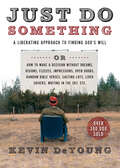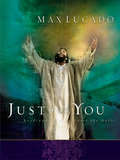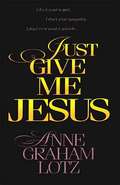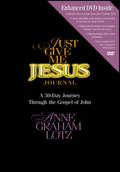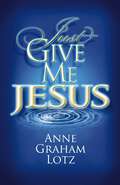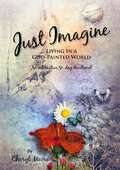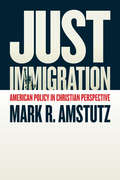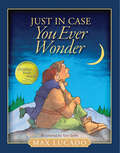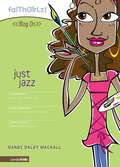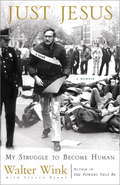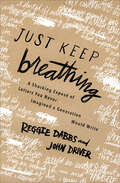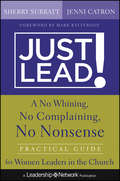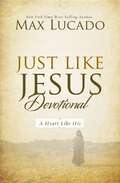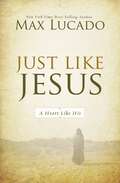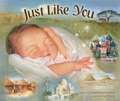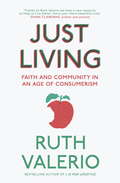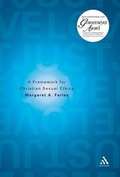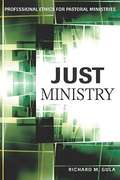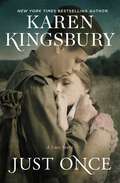- Table View
- List View
Just Do Something: A Liberating Approach to Finding God's Will
by Kevin DeYoungOVER 300,000 COPIES SOLD!Why won&’t God reveal his special will for my life already?Because he doesn&’t intend to... So says Kevin DeYoung in this punchy book about making decisions the godly way. Many of us are listening for the still small voice to tell us what&’s next instead of listening to the clear voice in Scripture telling us what&’s now. God does have a will for your life, but it is the same as everyone else&’s: Seek first the kingdom of God. And quit floundering. With pastoral wisdom and tasteful wit, DeYoung debunks unbiblical ways of understanding God&’s will and constructs a simple but biblical alternative: live like Christ. He exposes the frustrations of our waiting games and unfolds the freedom of finding God&’s will in Scripture and then simply doing it. This book is a call to put down our Magic 8-Balls and pick up God&’s Word. It&’s a call to get wisdom, follow Christ, be holy, and live freely. To just do something.
Just Do Something: A Liberating Approach to Finding God's Will
by Kevin DeYoungOVER 300,000 COPIES SOLD!Why won&’t God reveal his special will for my life already?Because he doesn&’t intend to... So says Kevin DeYoung in this punchy book about making decisions the godly way. Many of us are listening for the still small voice to tell us what&’s next instead of listening to the clear voice in Scripture telling us what&’s now. God does have a will for your life, but it is the same as everyone else&’s: Seek first the kingdom of God. And quit floundering. With pastoral wisdom and tasteful wit, DeYoung debunks unbiblical ways of understanding God&’s will and constructs a simple but biblical alternative: live like Christ. He exposes the frustrations of our waiting games and unfolds the freedom of finding God&’s will in Scripture and then simply doing it. This book is a call to put down our Magic 8-Balls and pick up God&’s Word. It&’s a call to get wisdom, follow Christ, be holy, and live freely. To just do something.
Just Enough: Vegan Recipes and Stories from Japan’s Buddhist Temples
by Gesshin Claire GreenwoodFresh out of college, Gesshin Claire Greenwood found her way to a Buddhist monastery in Japan and was ordained as a Buddhist nun. Zen appealed to Greenwood because of its all-encompassing approach to life and how to live it, its willingness to face life&’s big questions, and its radically simple yet profound emphasis on presence, reality, the now. At the monastery, she also discovered an affinity for working in the kitchen, especially the practice of creating delicious, satisfying meals using whatever was at hand — even when what was at hand was bamboo. Based on the philosophy of oryoki, or &“just enough,&” this book combines stories with recipes. From perfect rice, potatoes, and broths to hearty stews, colorful stir-fries, hot and cold noodles, and delicate sorbet, Greenwood shows food to be a direct, daily way to understand Zen practice. With eloquent prose, she takes readers into monasteries and markets, messy kitchens and predawn meditation rooms, and offers food for thought that nourishes and delights body, mind, and spirit.
Just For You
by Max LucadoThis artistic 4-color book will speak to the heart by combining the incredible images of The Visual Bible and the dynamic text of He Chose the Nails. Welcome the unmistakable power of the cross into your home as a witnessing tool, a conversation starter or simply a reminder of Christ's eternal sacrifice.
Just Give Me Jesus
by Anne Graham LotzAnne Graham Lotz encourages us to become closer to Jesus by learning who He is through eyewitness accounts.ts
Just Give Me Jesus
by Anne Graham LotzAfter two pressure-filled, life-changing years of professional exhaustion and personal turmoil, Anne Graham Lotz found herself with only one heart-cry, "Please, just give me Jesus." In this faith-inspiring book, she stares intently at the realities of life with her Savior. To those needing a fresh start, to those still searching for happiness, to those in need of forgiveness, to the suffering and the self-righteous alike, Jesus was, is, and will always be the answer.
Just Give Me Jesus
by Anne Graham LotzHow did the apostle John know that, two thousand years after he lived, your life would need a fresh touch from God?How did John know that, at the beginning of a new millennium,our lives would be so busy,our focus so divided,our bodies so tired,our minds so bombarded,our families so attacked,our relationships so strained,our churches so programmed . . .that we would be desperate for the simplicity and the purity, the freedom and the fulfillment of a life lived in Jesus' name?John probably didn't know. But God did. That's why He gives us Jesus! And that's why, as Anne Graham Lotz reveals, John's eyewitness account of Jesus' life is unmistakably relevant to your life today. The same Jesus who turned water into wine is the One who provides for your needs at this very moment. Enter into His life and find your soul refreshed with Living Water.This new edition of Just Give Me Jesus contains an in-depth devotional guide to help you explore the words of John in a personal and practical way, either on your own or in a group. You'll find inspiration and revelation as you study the Scripture more closely and record your reflections in space provided at the back of the book.
Just Imagine: Living In A God-Painted World
by Cheryl MooreImagination is the key to this unique kind of daily devotional book. Let’s call it the daily “encounter” book. Jesus wants you to experience Him, the Father, the Holy Spirit, and your world in new ways—using your imagination and your five senses. Together we’ll look at this beautiful world we live in and be amazed at the creative genius of God. Each day we take a “Flight of Fancy” after the reading where I’ll paint word pictures associated with the reading. I’ll walk you into the picture where you’ll find Jesus waiting there for you in a unique way or place that you’ve likely not thought of before. Each Flight of Fancy is designed to encourage you in your spiritual journey as you discover new ways to relate to the Father, Son, and Holy Spirit.My desire and prayer for you is that during your quiet encounter times you rediscover the God-sounds around you and enjoy learning to live in a God-painted, God-fragrant world…a world where He doesn’t always color inside the lines!
Just Immigration: American Policy in Christian Perspective
by Mark R. AmstutzFew issues are as complex and controversial as immigration in the United States. The only thing anyone seems to agree on is that the system is broken. Mark Amstutz offers a succinct overview and assessment of current immigration policy and argues for an approach to the complex immigration debate that is solidly grounded in Christian political thought. After analyzing key laws and institutions in the US immigration system, Amstutz examines how Catholics, evangelicals, and main-line Protestants have used Scripture to address social and political issues, including immigration. He critiques the ways in which many Christians have approached immigration reform and offers concrete suggestions on how Christian groups can offer a more credible political engagement with this urgent policy issue.
Just Immigration: American Policy in Christian Perspective
by Mark R. AmstutzFew issues are as complex and controversial as immigration in the United States. The only thing anyone seems to agree on is that the system is broken. Mark Amstutz offers a succinct overview and assessment of current immigration policy and argues for an approach to the complex immigration debate that is solidly grounded in Christian political thought. After analyzing key laws and institutions in the US immigration system, Amstutz examines how Catholics, evangelicals, and main-line Protestants have used Scripture to address social and political issues, including immigration. He critiques the ways in which many Christians have approached immigration reform and offers concrete suggestions on how Christian groups can offer a more credible political engagement with this urgent policy issue.
Just In Case You Ever Wonder (Max Lucado Ser.)
by Max LucadoJust In Case You Ever Wonder tells of a father's love for his child. This perennial best seller from Max Lucado will wrap your child in its tender message of love, comfort, and protection, showing that as they grow and change, you'll always be there for them.
Just Jazz
by Dandi Daley MackallJasmine "Jazz" Fletcher sees beauty and art where others see nothing. But if she doesn't come up with a commercially successful "masterpiece" soon, her parents may make her drop what they consider an unprofitable hobby. Through her work on the blog and on a public art project, Jazz, who has written off God, will move closer to understanding the Creator, the One who also sees the "unseen" (2 Corinthians 4:18) and closer to understanding that she is God's "masterpiece" (Ephesians 2:10).
Just Jesus
by Walter Wink Steven BerryUntil his death in 2012, Walter Wink was one of the most influential Christian intellectuals of our time. He was a pastor and theologian, a political activist and a writer. He first becme a practitioner of active nonviolence during the Civil Rights Movement in Selma Alabama, and continued to seek social justice for all under dictatorships in Chile and the apartheid in South Africa. Always through the lens of Jesus, Wink's life and work demonstrate just how important the need to understand "the Son of the Man" is in today's modern world. Wink shows us that inspiration and insight can come from any source: a Pentecostal Church in Oklahoma, dreams, Buddhist meditation centers, childhood traumas, an empty forest, illness, and the Gospels. Wink's work in social justice and his life as a theologian are inextricably entwined, finding evidence for nonviolent resistance in the Bible and seeing the need for Jesus in daily struggles. "An autobiography of my interest in Jesus, perhaps that is too ambitious," writes Wink. "What I have done here is far less grand. I have simply written down vignettes, or excerpts of my life's story that I find interesting. These autobiographical reflections are in no way exceptional. Everyone has a life story. My story may, at the very least, show why I theologically think the way that I do." Just Jesus is the jubilant autobiography of the man who sought justice in all walks of life, including his own.
Just Keep Breathing: A Shocking Exposé of Letters You Never Imagined a Generation Would Write
by John Driver Reggie DabbsA candid, intimate look at teens in crisis: “Heartrending . . . startling . . . a resource for understanding and approaching the life-changing pitfalls of youth.” —Publishers Weekly“I get abused and hurt so much, and no one seems to care . . . ” These are real words written by a real girl. There are thousands more just like her. Her pain is real. Her story is true. But her voice has been hidden . . . until now.The desperate words of a generation have too often been drowned out by the white noise of a culture too busy to care. For those who dare to listen, there are incredible stories to be unearthed, filled with both tragedy and triumph. This book was written in response to thousands of personal letters and messages, meant for both those in crisis and those who share that crisis with them every day. As a sought-after public speaker, Reggie Dabbs has shared his own incredible story with millions of students—and many of them share their stories with him in return. These letters contain those stories, with only names and details changed to protect their anonymity. They are followed by Reggie’s actual response of hope to that individual. John Driver, MS—a former public secondary educator, as well as a longtime community youth advocate and mentor—provides additional insight and “Breathable Moments” for educators, parents, friends, and family.Equipping readers to help those in crisis continue breathing another day, Just Keep Breathing provides both the inspiration and the information needed to respond confidently and appropriately—and see those we care about make it to another sunrise.
Just Lead!: A No Whining, No Complaining, No Nonsense Practical Guide for Women Leaders in the Church (Jossey-Bass Leadership Network Series #67)
by Jenni Catron Sherry SurrattBecome the effective woman leader God intended you to be Just Lead! provides practical leadership help for women to develop skills to lead themselves and others with the character, confidence and authenticity of a godly woman. The book shows what holds women back and then focuses the skills women need to lead others effectively. Using this hands-on, practical resource will inspire women leaders in the church to use its ideas to gain strength and lead well. Helps women successfully navigate the transitions necessary to lead well in church and ministry settings Offers women a practical guide for breaking the "stained-glass window" and becoming effective leaders Addresses leadership issues such as leading mixed gender teams, earning and giving respect, and navigating through relational landmines Just Lead! challenges women to embrace their identity as leaders and equips them with the skills they need to lead others well.
Just Like Jesus Devotional: A Thirty-day Walk With The Savior
by Max LucadoGod wants to give you a heart just like Jesus.Jesus felt no guilt; God wants you to feel no guilt.Jesus had no bad habits; God wants to do away with yours.Jesus had no fears; God wants the same for you.Jesus had no anxiety about death; you needn't either.God's desire, his plan, his ultimate goal is to make you into the image of Christ.This is your invitation to spend thirty intimate days with the Savior learning how to become more like Jesus. Can you think of a better offer?
Just Like Jesus: A Heart Like His
by Max LucadoGod loves you just the way you are, but he refuses to leave you there. He wants you to be just like Jesus.<P><P> Can you think of a better offer?<P> Jesus felt no guilt; God wants you to feel no guilt. Jesus had no bad habits; God wants to do away with yours. Jesus had no fears; God wants the same for you. Jesus had no anxiety about death; you needn't either. God's desire, his plan, his ultimate goal is to make you into the image of Christ.<P> But how does this change occur? And why does the change seem so slow? If God wants me to be just like Jesus, why do I still seem just like me?<P> In Just Like Jesus, Max Lucado helps you answer these questions. He helps you understand God's wonderful ways of transformation. Would you like to know more? Then read on. And remember: God loves you just way you are, but he refuses to leave you there. He wants you to be just like Jesus.
Just Like You: Beautiful Babies Around the World
by Lin Wang Marla Stewart KonradOn the day you were born, God wrapped his gentle arms around the whole world. What do a crackling fire, a tinkling rattle, and beaded necklaces have in common? They are gifts welcoming brand-new babies into the world—babies just like you. Global families form the centerpiece of this heartwarming story that reminds us of the universal bonds between loved ones. Discover celebrations of life from every continent, under the same sparkling stars, in this reassuring tribute to the all encompassing embrace of God’s love.
Just Living: Faith and Community in an Age of Consumerism
by Ruth ValerioGlobalisation and consumerism affect every area of our lives. But it's not just about shopping; these powerful forces shape our personal lives, how we relate to one another, how we view the world - and they are having a seriously detrimental impact both on the lives of the global poor, and on the health of the planet itself.Every Christian in every generation down through the history of the church has had to work out what it means to be a follower of Jesus in their particular culture; for us in the twenty-first century, we must think about discipleship in a globalised, consumerist context. Environmentalist and theologian Ruth Valerio examines these issues in a book that is intellectually rigorous yet practical, and as inspiring as it is challenging.
Just Living: Faith and Community in an Age of Consumerism
by Ruth ValerioGlobalisation and consumerism affect every area of our lives. But it's not just about shopping; these powerful forces shape our personal lives, how we relate to one another, how we view the world - and they are having a seriously detrimental impact both on the lives of the global poor, and on the health of the planet itself.Every Christian in every generation down through the history of the church has had to work out what it means to be a follower of Jesus in their particular culture; for us in the twenty-first century, we must think about discipleship in a globalised, consumerist context. Environmentalist and theologian Ruth Valerio examines these issues in a book that is intellectually rigorous yet practical, and as inspiring as it is challenging.
Just Love: A Framework for Christian Sexual Ethics
by Margaret A. Farley FarleyThis long-awaited book by one of American Christianity's foremost ethicists proposes a framework for sexual ethics whereby justice is the criterion for all loving, including love that is related to sexual activity and relationships. It begins with historical and cross-cultural explorations, then addresses the large questions of embodiment, gender, and sexuality, and finally delineates the justice framework for sexual ethics. Though" Just Love"s particular focus is Christian sexual ethics, Farleys framework is broad enough to have relevance for multiple traditions. Also covered are specific issues in sexual ethics, including same-sex relationships, marriage and family, divorce and second marriage, celibacy, and sex and its negativities.
Just Ministry: Professional Ethics For Pastoral Ministers
by Richard M. GulaJust Ministry is a book on professional ethics for those involved in pastoral ministry, whether ordained or lay. It aims to stimulate a new attitude among ministers to view themselves as professionals and to take seriously the responsibilities that come with this identity. At a time when concerns for misconduct, scandals of abuse, and liability have brought pastoral ministers under greater scrutiny than ever before and have threatened to undermine their morale, this book offers a positive perspective on the vocation of pastoral ministry and wise ethical guidance to foster integrity in ministry. In this way it is a resource of preventative education for pastoral ministry. By examining the professional aspects of a ministerial vocation, it provides a guide for ministers to be accountable in offering their pastoral service with expert knowledge and skill and with good moral character. It builds upon a theology of vocation, a covenantal model of ministry, and a vision of professional identity.
Just Nicholas
by Annie KratzschRead the true story of Saint Nicholas of Myra, the man who gave what he had to help others because he was grateful for what God had given him. As a young boy, Nicholas learned the story of Jesus from his parents. When he grew up, he lived out his Christian faith in a unique and selfless way that we still celebrate today. The stories we tell about Santa Claus say that he gives only to those who are 'good' or 'nice'. The story of Nicholas reminds us that God gives based not on what we deserve but on his overflowing love for us. A helpful parent resource section includes questions to explore with your children as you read Just Nicholas and make 'the man before Santa' part of your Christmas tradition. Limited picture descriptions present.
Just Once: A Novel
by Karen KingsburyThe #1 New York Times bestselling author &“known for her deeply heartfelt novels&” (Woman&’s World) writes a sweeping World War II love story about a young woman torn between two brothers.In 1941, beautiful Irvel Holland is too focused on her secret to take much notice of the war raging overseas. She&’s dating Sam but in love with his younger brother, Hank—her longtime best friend—and Irvel has no idea how to break the news. Then the unthinkable happens—Pearl Harbor is attacked. With their lives turned upside down overnight, Sam is drafted and convinces Hank to remain in Indiana, where he and Irvel take up the battle on the home front. While Sam fights in Europe, an undeniable chemistry builds between Irvel and Hank but neither would dare cross that line. Then, two military leaders pay Irvel a visit at the classroom where she teaches. The men have plans for her, a proposition to join a new spy network. One catch: She can tell no one. With Irvel caught between two brothers thousands of miles apart, can love find a way, even from the ashes of the greatest heartbreak?
Just One Jew: The Grandson of a Gadol Tells His Story
by Moishe MendlowitzIn this inspiring, fascinating, and exciting book, the author brings the reader into his inner world, telling a tale that will have you crying, laughing and thinking--about the power of just one Jew.
